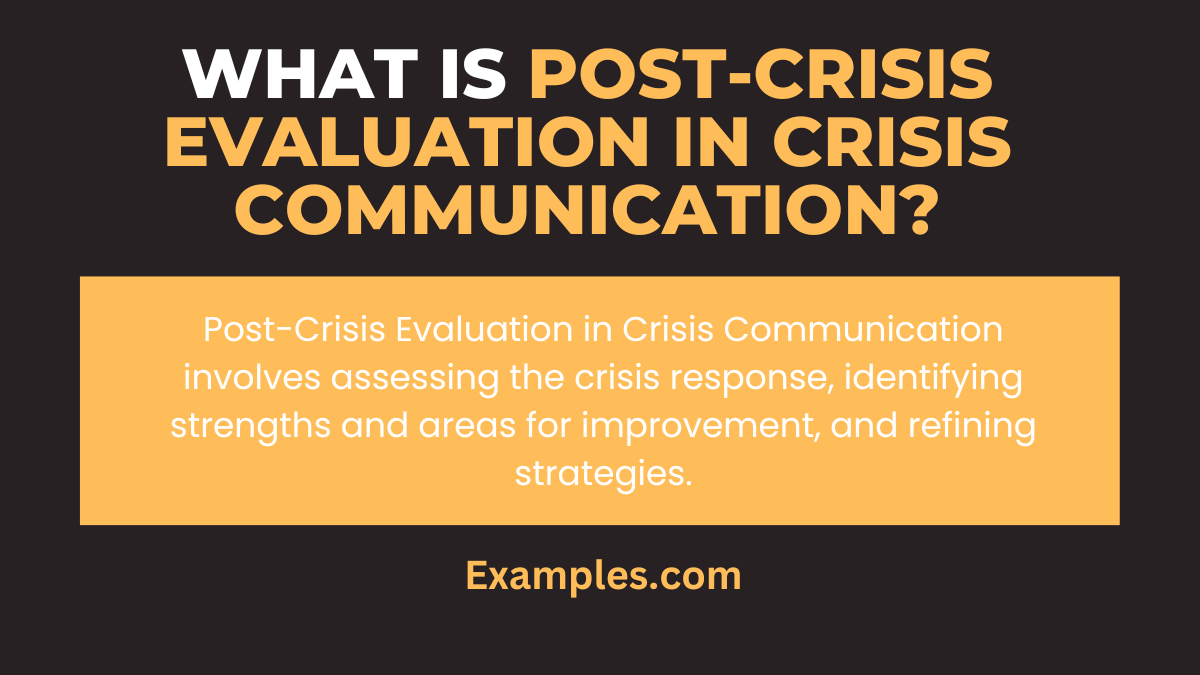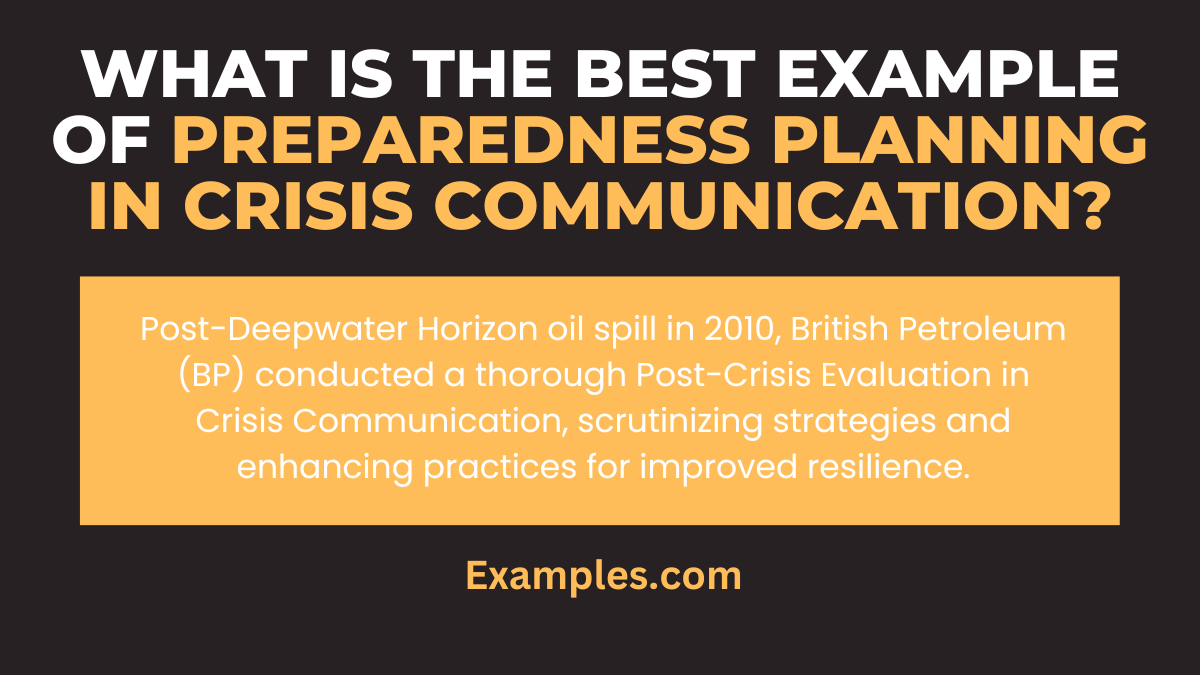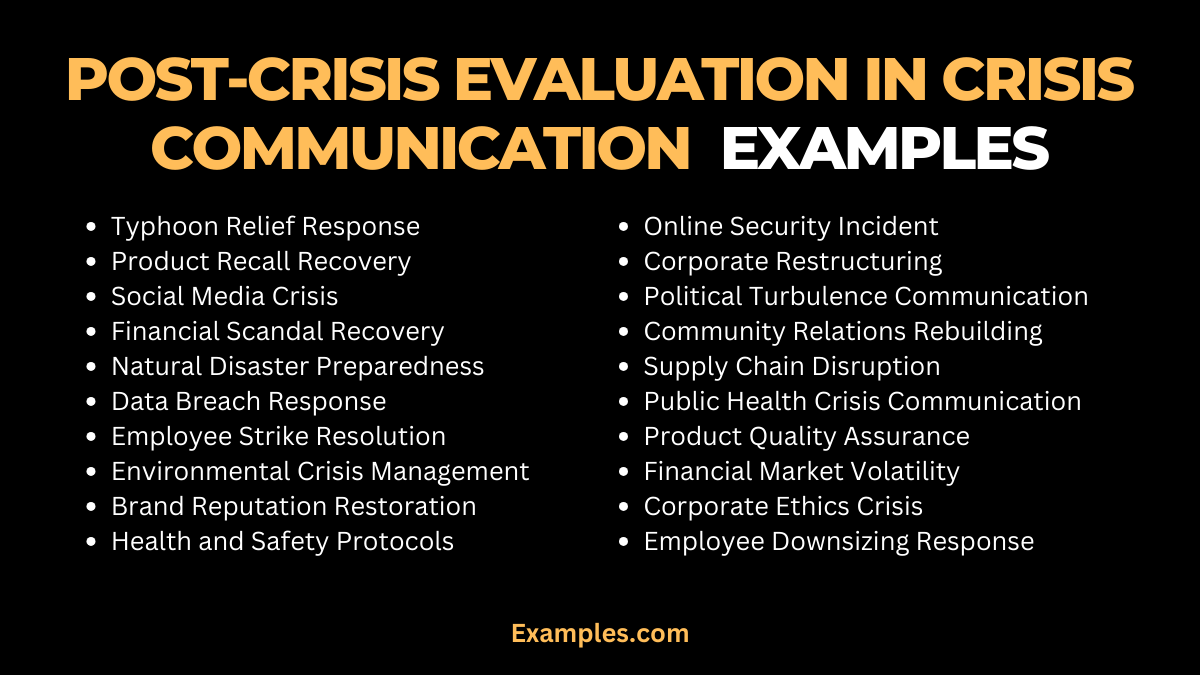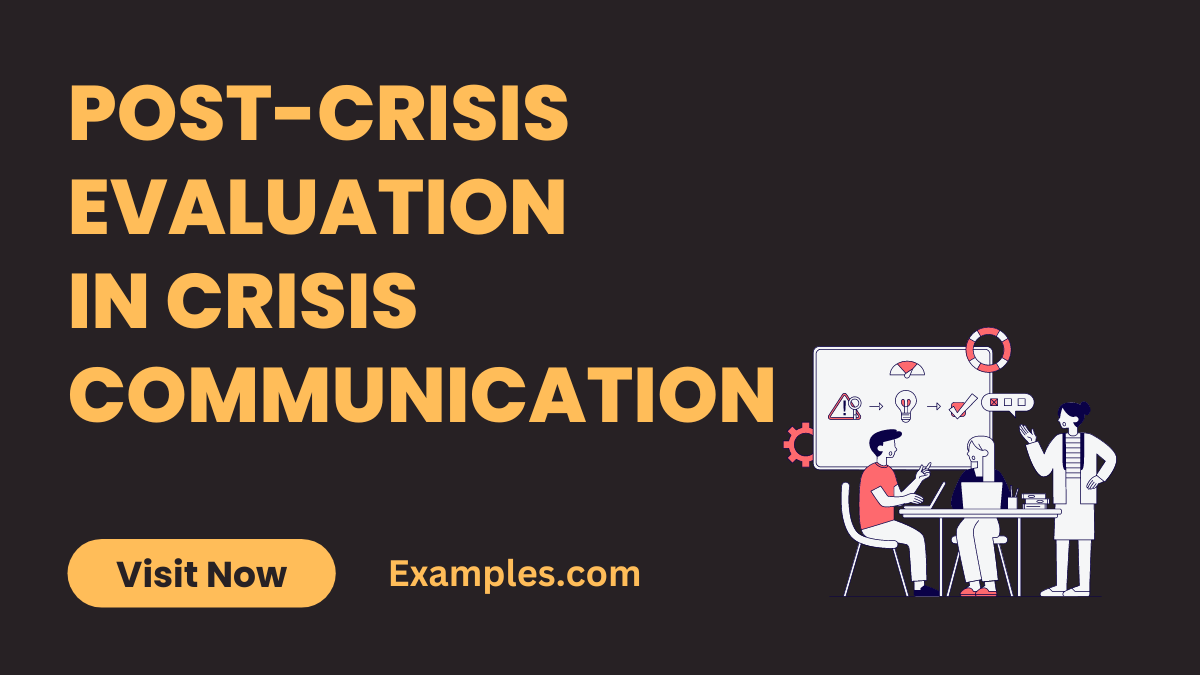19+ Post-Crisis Evaluation in Crisis Communication Examples
Embark on a comprehensive exploration of Post-Crisis Evaluation in Crisis Communication, a pivotal phase in strategic recovery. This complete guide not only dissects the intricacies of post-crisis assessment but also illuminates the path with real-world Communication Examples. Gain insights into effective evaluation methods, refine your crisis response strategy, and glean invaluable lessons from instances where post-crisis communication played a decisive role in rebuilding trust and resilience. Elevate your crisis management skills with this insightful and practical resource.
What is Post-Crisis Evaluation in Crisis Communication?

Post-Crisis Evaluation in Crisis Communication refers to the systematic process of assessing and analyzing an organization’s response and communication strategies following a crisis. It involves a thorough examination of what worked well, what could be improved, and the overall effectiveness of communication efforts. This evaluation is essential for refining future crisis response plans, enhancing communication strategies, and fostering organizational learning from past challenges to ensure a more resilient and proactive approach in the future.
What is the Best Example of Post-Crisis Evaluation in Crisis Communication?

Following the Deepwater Horizon oil spill in 2010, British Petroleum (BP) conducted a robust Post-Crisis Evaluation in Crisis Communication. The evaluation involved a comprehensive analysis of BP’s communication strategies during the crisis. It scrutinized the effectiveness of their messaging, transparency, and engagement with stakeholders. By critically assessing their response, BP identified areas for improvement, leading to enhanced crisis communication practices. This example highlights the importance of post-crisis evaluation in refining strategies and fortifying communication resilience.
20 Post-Crisis Evaluation in Crisis Communication Examples

Explore 20 real-world instances showcasing the impact of Post-Crisis Evaluation in Crisis Communication. This curated collection offers insights into the strategic assessment of communication efforts after crises, providing valuable lessons for refining future response plans.
- Typhoon Relief Response (2019): Post-crisis evaluation highlighted the need for clearer communication channels, guiding improved relief efforts for better community support.
- Product Recall Recovery (2015): A meticulous evaluation after a product recall led to revamped communication strategies, restoring consumer trust through transparent messaging.
- Social Media Crisis (2020): Following a viral crisis, social media evaluation shaped proactive communication strategies, effectively managing public perception through timely updates.
- Financial Scandal Recovery (2017): Post-crisis assessment guided financial institutions in rebuilding credibility, emphasizing transparent communication and ethical practices.
- Natural Disaster Preparedness (2018): Evaluating crisis preparedness post a natural disaster refined communication plans, ensuring more effective warnings and timely information dissemination.
- Data Breach Response (2016): Post-crisis evaluation improved data breach communication, emphasizing customer privacy and implementing robust cybersecurity measures.
- Employee Strike Resolution (2019): Assessing communication during an employee strike paved the way for improved dialogues, minimizing disruptions and fostering a better employer-employee relationship.
- Environmental Crisis Management (2014): Evaluation of an environmental crisis response informed proactive communication, emphasizing sustainable practices and community engagement.
- Brand Reputation Restoration (2016): A thorough evaluation post a reputation crisis guided brand communication, rebuilding trust through transparent messaging and ethical practices.
- Health and Safety Protocols (2021): Assessing health crisis communication refined safety protocols, ensuring clear, concise information for employees and stakeholders.
- Online Security Incident (2017): Evaluation post an online security incident informed improved communication strategies, emphasizing cybersecurity measures and customer reassurance.
- Corporate Restructuring (2018): Post-crisis assessment after a restructuring informed communication strategies, fostering transparency and employee morale.
- Political Turbulence Communication (2019): Evaluating communication during political turmoil refined strategies, emphasizing neutrality and ensuring stakeholders were well-informed.
- Community Relations Rebuilding (2015): Post-crisis assessment guided community relations, fostering open communication and collaboration for long-term positive impact.
- Supply Chain Disruption (2020): Assessing communication after a supply chain disruption refined crisis plans, ensuring stakeholders received timely and accurate updates.
- Public Health Crisis Communication (2018): Evaluation post a public health crisis informed better communication strategies, emphasizing empathy and timely information sharing.
- Product Quality Assurance (2016): Post-crisis assessment improved product quality communication, ensuring transparency and rebuilding consumer confidence.
- Financial Market Volatility (2017): Evaluation during financial market volatility refined communication, ensuring stakeholders were well-informed and confident in the organization’s strategy.
- Corporate Ethics Crisis (2019): Assessing communication during an ethics crisis informed improved messaging, emphasizing commitment to ethical practices and accountability.
- Employee Downsizing Response (2017): Post-crisis evaluation refined communication strategies during downsizing, emphasizing transparency and providing support for affected employees.
Post-Crisis Evaluation in Crisis Communication Examples in Healthcare
Delve into real-world instances illustrating the pivotal role of Post-Crisis Evaluation in Healthcare Communication. Uncover how meticulous assessments have shaped strategies, ensuring effective communication and trust restoration in the healthcare sector post-crisis.
- Hospital Cyberattack Response (2020): In the aftermath of a cyberattack, a healthcare institution’s evaluation guided improved communication, emphasizing data security and patient reassurance.
- Pandemic Preparedness (2016): Evaluation following a pandemic refined healthcare communication, focusing on transparent updates, preventive measures, and community engagement.
- Vaccine Adverse Effects Communication (2018): Post-crisis assessment enhanced communication around vaccine adverse effects, emphasizing clarity and providing actionable information for concerned individuals.
- Patient Safety Incident (2017): A detailed evaluation following a safety incident improved communication protocols, ensuring transparent disclosure, and emphasizing ongoing safety measures.
- Mental Health Crisis Management (2019): Post-crisis assessment in mental health crises refined communication strategies, emphasizing empathy, accessible resources, and destigmatizing mental health discussions.
Post-Crisis Evaluation in Crisis Communication Examples at Work
Explore how Post-Crisis Evaluation in Workplace Communication shapes effective strategies, fostering resilience and trust. These examples unveil how assessments have informed communication practices, minimizing disruptions and enhancing employee engagement.
- Employee Feedback Incorporation (2018): Post-crisis evaluation incorporated employee feedback, shaping communication that addressed concerns and showcased commitment to improvement.
- Leadership Change Communication (2019): Assessment after a leadership change refined communication strategies, emphasizing transparency, outlining the vision, and fostering trust among employees.
- Workplace Harassment Response (2017): Evaluation post a harassment incident informed improved communication, prioritizing employee well-being and ensuring a safe reporting process.
- Organizational Restructuring (2020): Post-crisis assessment during organizational restructuring refined communication, emphasizing clarity about changes, employee support, and a vision for the future.
- Remote Work Transition (2021): Assessment during the transition to remote work informed communication strategies, emphasizing clear guidelines, technological support, and maintaining a sense of connection among remote teams.
What are the Stages of Post-Crisis Evaluation in Crisis Communication?
Navigating post-crisis evaluation involves distinct stages:
- Immediate Assessment: Swiftly gauge the crisis impact on communication strategies and identify immediate areas for improvement.
- Data Collection: Gather comprehensive data on crisis response, analyzing communication channels, message effectiveness, and stakeholder feedback.
- Root Cause Analysis: Identify the root causes of communication challenges during the crisis, understanding the factors influencing effectiveness.
- Effectiveness Evaluation: Assess the overall effectiveness of communication strategies in achieving predefined goals.
- Stakeholder Feedback Incorporation: Integrate feedback from stakeholders, including internal teams and external parties, to gain diverse perspectives.
- Comparison to Standards: Benchmark the crisis communication against industry standards, regulations, and best practices to identify areas for alignment.
- Documentation: Document all findings, insights, and lessons learned during the post-crisis evaluation for future reference and continuous improvement.
What is the Approach of Post-Crisis Evaluation in Crisis Communication?
An effective approach involves the following steps:
- Objective Setting: Define clear objectives for the evaluation, focusing on specific communication aspects, stakeholder perceptions, and overall strategy effectiveness.
- Multidisciplinary Team Involvement: Form a multidisciplinary evaluation team, including communication experts, crisis management specialists, and key stakeholders.
- Timeline Establishment: Set a realistic timeline for the evaluation, ensuring a comprehensive assessment without unnecessary delays.
- Data Gathering Strategies: Employ diverse data collection methods, including surveys, interviews, and analysis of communication artifacts, for a holistic understanding.
- Root Cause Identification: Dig deep into identifying root causes of communication challenges, acknowledging both internal and external influences.
- Collaborative Analysis: Foster collaboration during the analysis phase, encouraging open discussions and diverse perspectives to enhance insights.
- Actionable Recommendations: Generate actionable recommendations based on evaluation findings, prioritizing improvements that align with organizational goals.
How to Create Post-Crisis Evaluation in Crisis Communication?
Follow these steps to create an effective post-crisis evaluation:
- Establish Evaluation Criteria: Define criteria aligned with communication goals, considering clarity, timeliness, stakeholder engagement, and overall impact.
- Select Evaluation Methods: Choose appropriate evaluation methods, such as surveys, focus groups, and performance metrics, ensuring a comprehensive data collection approach.
- Identify Key Performance Indicators (KPIs): Determine KPIs relevant to communication effectiveness, allowing for quantitative measurement of success.
- Create a Detailed Evaluation Plan: Outline a step-by-step plan, specifying responsibilities, timelines, and resources required for each stage of the evaluation process.
- Implement Data Collection: Execute the evaluation plan, ensuring accurate and timely data collection to provide a solid foundation for analysis.
- Thorough Analysis: Conduct a thorough analysis of the collected data, identifying patterns, trends, and areas for improvement.
- Feedback and Iteration: Share evaluation findings with relevant stakeholders, gather additional feedback, and iterate the evaluation process based on insights gained.
- Documentation and Reporting: Document all aspects of the evaluation process and create a comprehensive report outlining key findings, recommendations, and lessons learned.
- Continuous Improvement Integration: Integrate the evaluation insights into future crisis communication strategies, fostering a culture of continuous improvement and resilience.
In conclusion, this comprehensive guide unveils the essence of Post-Crisis Evaluation in Crisis Communication. Through insightful examples and step-by-step guidance, organizations can harness the power of assessment to refine strategies, restore trust, and fortify resilience. Embrace the lessons learned from real-world instances to navigate the aftermath of crises with precision, ensuring effective communication and sustainable recovery.



